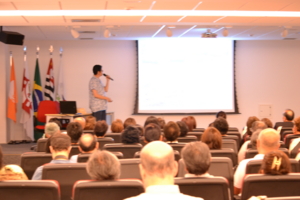ボンジーア!
サンパウロからyuiです。
事業のお手伝いでサンパウロに出張中です。
今日は前回に引き続き、サンパウロでの和太鼓公演の報告です!
Bom dia!
This is yui from Sao Paulo.
Now I'm in Sao Paulo to support many events taking place here.
Following the previous article, I'll report on Wadaiko workshop and performance in Sao Paulo.
この和太鼓公演は国際交流基金サンパウロ日本文化センターと、在サンパウロ総領事館の共催事業で、震災後に日本への応援メッセージをくれた学校の子どもたちを対象としたワークショップ、一般向けの和太鼓公演を行ったものです。
公演では、メニーノス・モルンビーというストリートチルドレンやさまざまな事情で施設で育った子どもを含む、子どもたちのサンバ・パフォーマンスのチームと和太鼓グループの「生(しょう)」が共演しました。
http://fjsp.org.br/agenda/wadaikosho_meninosdomorumbi/
The workshop and performance were co-hosted by the Japan Foundation, Sao Paulo and Consulate General of Japan in Sao Paulo in order to express our gratitude to Brazil for supporting Japan since 3.11.
The workshop was only for school kids who sent messages to Tohoku area after the earthquake to cheer up people in Tohoku while the performance was open to the public.
Menios do Morumbi, a samba performance group that includes children who used to live on the streets or have grown up in orphanages performed in collaboration with a Wadaiko performance group, Sho.
http://fjsp.org.br/agenda/wadaikosho_meninosdomorumbi/
公演に先立って行われたワークショップでは、まず生のみなさんがお手本を披露。
子どもたちはビデオや写真を撮ったりしながら聞き入っていました。演奏後には大きな歓声と拍手!
このあと、子どもたちも生のメンバーの方から説明を受けながら、和太鼓演奏の体験です。
わたしも、僕も、やりたい!で大混乱。笑
Before the workshop, members of Sho gave a short demonstration, which was very impressive for children.
They took photos and videos, and after the demonstration it exploded with big applause and cheering.
And then it was time for children to try Wadaiko under the instruction of Sho members!
Everyone wanted to play Wadaiko, so they fell into chaos. lol
みんなとっても楽しそう。
でもやっぱりみんなで合わせるのはなかなか難しく、生のみなさんがぴたっと揃った演奏をするのはさすがだなーと体感しました。
It seemed that children enjoyed the workshop very much!
But it was so hard to put all the sounds together, which made us realize that the members of Sho were surely professional.
ワークショップの後、一般のお客さんを迎えて公演開始!
まずはメニーノス・モルンビーによるサンバのパフォーマンス。
パーカッションに、歌に、ダンスに、とってもにぎやか。
ダンサーの子どもたちはとにかくダンスが上手い!ダンス好きの私にはうらやましすぎるリズム感。。
そしてなによりもパフォーマーの子どもたちの明るい笑顔がとっても印象的でした。
When the workshop ended, we welcomed public audiences!
First, Meninos do Morumbi was on stage and presented samba performance.
They had percussion, singing and dance. So spectacular!
Kids dancers were very skilled and very cool! For me as a dance lover, their remarkable talents were really enviable!!
And the most of all, bright and attractive smiles on the children’s faces were pretty impressive.
そしてサンバのあとには和太鼓。
観客席をとおっての入場から、迫力満点のステージ。
途中には震災時の様子やその後の被災地の様子をまとめた映像に合わせての笛や太鼓の演奏、あたたかい支援をくれたブラジルへの感謝のメッセージに会場は大きな拍手に包まれました。
Following Menios do Morumbi, Wadaiko was on show.
Members came into the hall through the audience. Their performance was overwhelming and amazing.
In the middle of the performance, there was a short video on the earthquake and tsunami that struck Tohoku on 3.11 and the region's status after 3.11 accompanied by Fue (Japanese flute) and Taiko. This performance was to express our gratitude to warm support from Brazil.
最後は和太鼓とサンバの共演!
メニーノス・モルンビーの子どもたちがステージに登場し、サンバのパーカッションと和太鼓のコラボレーションに、さらにダンスと歌がついてきます!
会場はもはや大盛り上がり。
パフォーマンスが終わると会場総立ちのスタンディング・オベーションでした!
思いがひとつになるときは、国境や文化の違いは大きな問題ではないのかもしれませんね。
こういうシーンに立ち会ってしまうと、この仕事はやめられなくなるんだなぁなんていうことも感じた瞬間でした。
At the end of the stage, Wadaiko met Samba!!
The members of Meninos do Morumbi appeared on the stage, which brought the collaboration of samba percussion, Wadaiko, dance and singing. The audience was thrilled and gave a standing ovation!
When everyone's feeling become one, boundaries or cultural differences are not a big problem.
It is for me the most remarkable moment while engaging in international cultural exchange programs.
ではまた!
tchau!





















